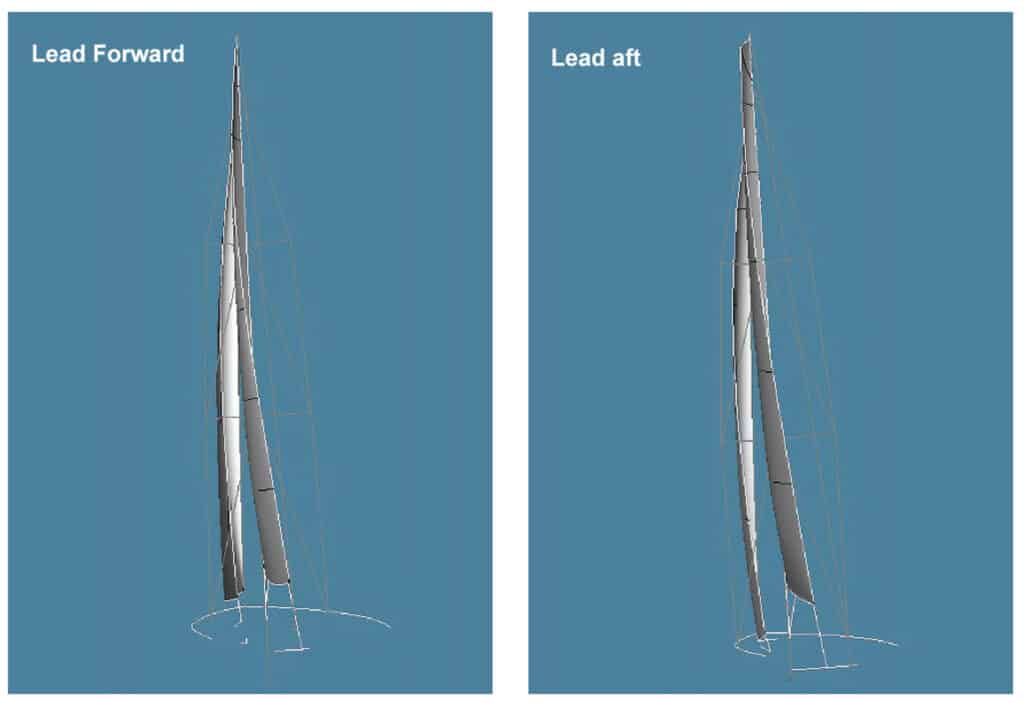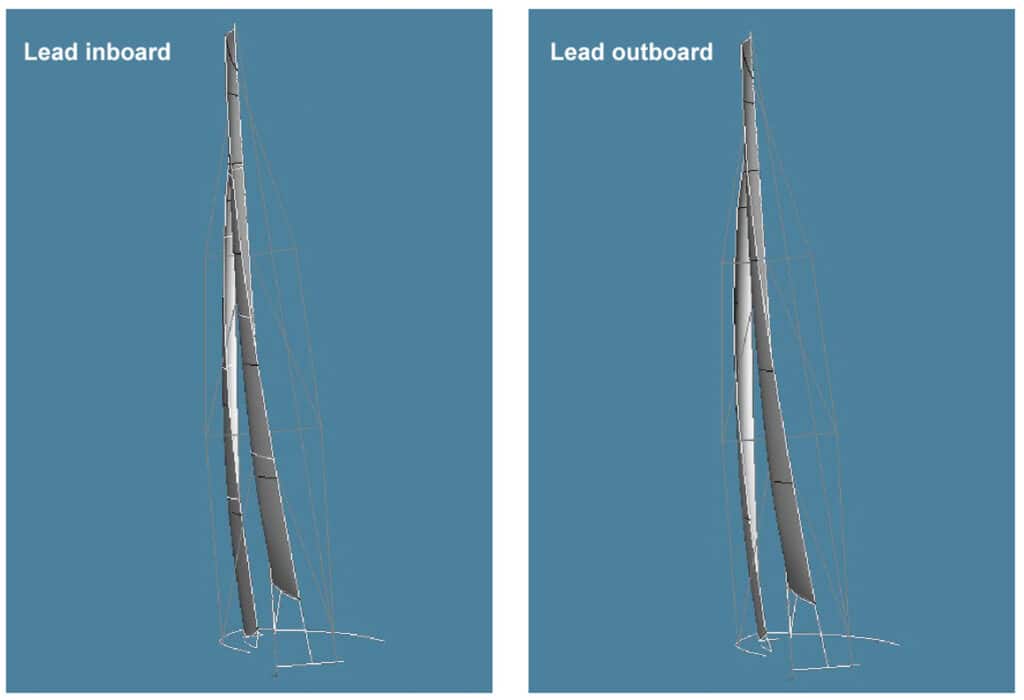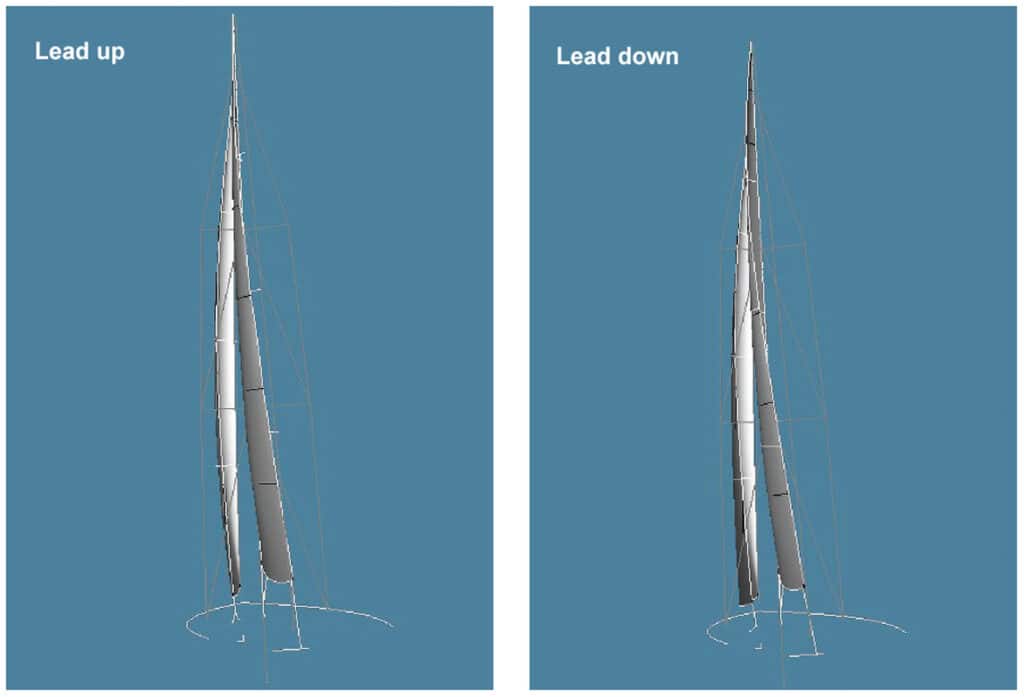Visible forward progress at the grand-prix level our sport is defined exclusively by speed records and foiling appendages, but meaningful innovation can also enter the scene in an unassuming manner. Small modifications aggregate over time and, when you take a step back, you realize that the system bears little resemblance to its former self. This is certainly the case with modern-day headsail trimming systems. What was once a metal track running along the sheerline for sheeting low-aspect, stretch-prone headsails is now typically a floating low-friction ring with three-dimensional controls for trimming high-aspect, high-modulus headsails.
Walk the docks of an ORC regatta, a one-design championship, or even a beer-can race and you will notice how many boats are now equipped with some version of a floating headsail lead. With the broadened range of lead positioning available and the ability to make fine adjustments, knowledgeable trimmers can contribute substantial performance gains to any boat they step onto. Understanding the proper balance of foot depth and leech twist to achieve target performance numbers is, of course, the first step toward accessing these new gears. But knowing when to stray from the perfect setup in order to power through asymmetric chop, hold a tight lane off the start line, split low and fast out of a crowded leeward mark, or extend from a closely trailing boat on the offset leg will set you apart from the crowd of average trimmers. Let’s take a look at each axis of lead positioning and its effect on the sail.
Fore and aft: Optimizing the longitudinal jib-lead position
Fore and aft movement of the lead position primarily controls foot depth. Moving the lead forward will increase depth in the lower part of the sail, while moving it aft will flatten it. The side effect of this movement is leech twist control. As the foot gets fuller, the leech becomes straighter and more closed at the top of the sail. As the foot gets flatter, the leech becomes more twisted. This has historically been the most common axis for adjustment because, in a basic sense, both flattening the foot and twisting the leech are methods of depowering the sail. When we factor in the nuances of sea state, vertical wind shear, tolerances of groove width, and efficient mode shifting, longitudinal control alone limits the versatility of our headsail.

Inboard and outboard: Optimizing the athwartships jib-lead position
Controlling the athwartships position of the lead is typically referred to as inhauling. Moving the lead inboard narrows the angle of attack. All else equal, this means the boat must point higher in order for the wind to view the headsail the same way as it was before being inhauled. The major limitation here is when the slot between the headsail and mainsail becomes too narrow and the flow coming off the jib inverts the front of the mainsail.
The goal of setting the athwartships lead position is to set the jib leech close enough to the main that it compresses and accelerates the wind between the two sails and forces the flow over the back of the main to remain attached farther aft than it would otherwise, but not so narrow that it bubbles the front of the main and creates an unreasonably thin groove for the driver. When I decide where to set the inhauler, I typically check for just a touch of visual feedback (light fluttering) in the main luff and communicate with the driver about how easy it is to keep the boat tracking well. In a lumpy sea state, for example, the driver will need a wider angle of attack in order to have adequate freedom to maneuver through the waves.

Up and down: Optimizing the vertical jib-lead position
The up and down control of your lead position can be seen as having a similar effect as the fore and aft control does. However, changing the up and down position has a more direct effect on the leech twist and a more indirect effect on foot depth. As headsails have become higher-aspect, having more precise control of the leech twist has become increasingly important. This is likely why vertical lead adjustment has been added to many boats or replaced the longitudinal adjustment altogether.

Now that we understand the impact of each control axis, how do we find the sweet spot for our floating jib lead at any given moment? A good starting point is to follow the classic guidance of achieving an evenly breaking luff. The jib clew should be low enough that the luff telltales at the head aren’t breaking drastically earlier than the ones closer to the foot are, but not so low that the upper leech telltales are stalling from too little twist.
The clew should be far enough forward that there is enough power in the foot to achieve target speeds at upwind polar angles, but not so far forward that the depth induces too much drag and the upper leech is, once again, stalling. The clew should be inboard enough to maximize upwind pointing ability, but not so far inboard that it overly compresses flow through the slot, disturbing the luff of the main.
Of course, we don’t have the luxury of each adjustment functioning in isolation. We must also understand how each control impacts the complete setup and how to correct unwanted impacts. Inhauling the jib can also increase the foot depth, so to achieve a narrower angle of attack without creating unwanted drag, we must move the lead up, shift the lead back, or pull the sheet on harder. Easing the lead up can allow the clew to fall to leeward, so we can inhaul more to bring the angle of attack back to where it was. Because of this interconnected relationship between the floating lead control lines, it can be difficult to make reliable marks and repeat settings precisely. This means trimmers need to be overly discerning when it comes to the proper look of the jib. We need to check in regularly on the luff telltales, leech telltales, and feedback in the main to visualize the flow over our sail.
Adding one more layer to the puzzle of determining jib-lead setup is input from the tactician. Aside from the methods outlined above for achieving efficient upwind trim, floating jib leads are also beneficial to short-term mode shifts. For example, if there is a tactical call for a high mode off the start line to clear or protect a good lane, the headsail trimmer should inhaul the jib as the main trimmer moves the traveler up. The groove will be narrow and speed will suffer slightly, but when done efficiently, the task can be completed quickly before transitioning right back to the best VMG mode. When sailing off the wind, the floating lead allows for much greater ability to keep the sail trimmed properly without requiring flattening sheets or outboard leads.
A good trimmer knows how to make their jib look nice and perform well. A great trimmer will cross-reference their settings with the main trim, helm balance and tactical mode to increase the performance of the entire system.









